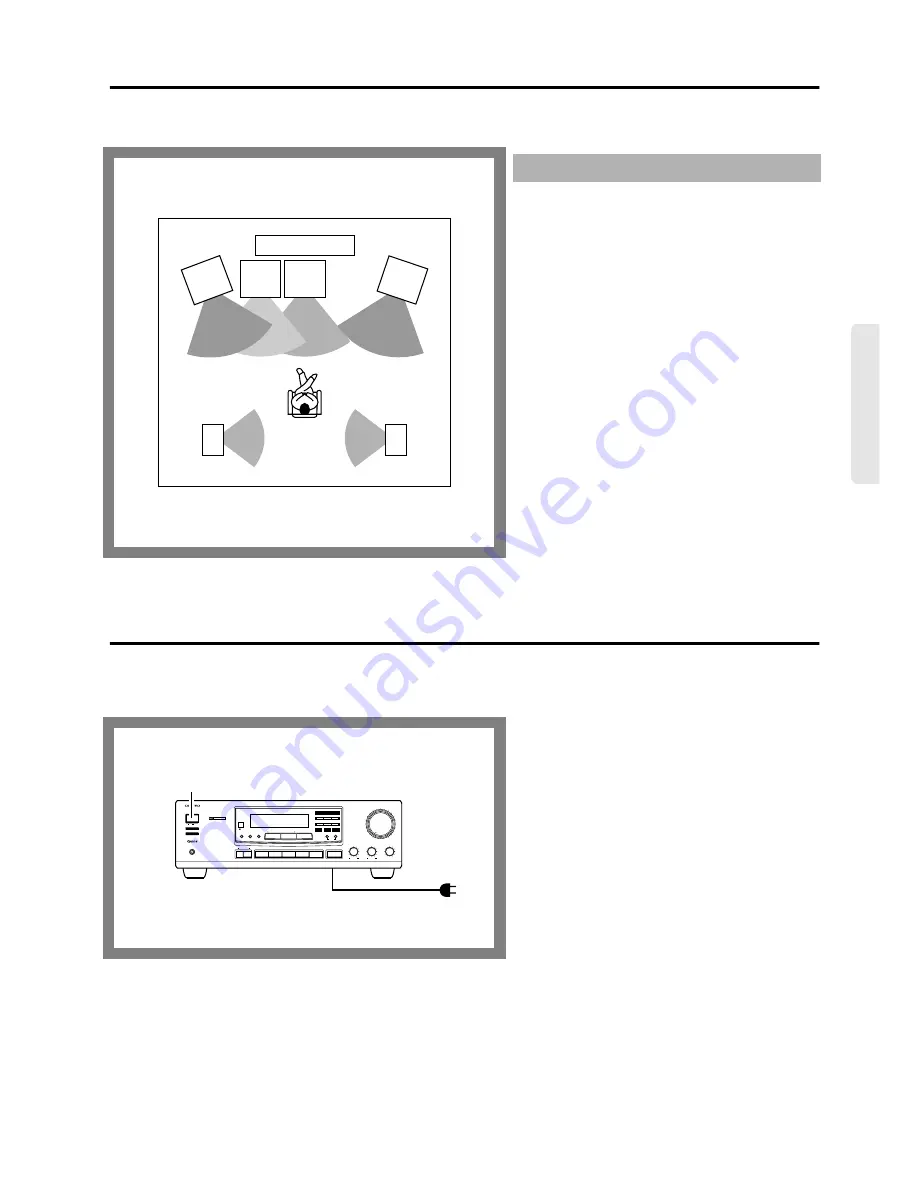
9
Positioning speakers
Speaker placement plays an important role in the reproduction of Surround sound. The manner in which the speakers are placed varies
depending on the size of the room and the wall coverings used in the room. The illustration below shows an example of a layout for standard
speaker placement. Refer to this example when positioning the speakers in order to experience the best of Surround sound.
For ideal Surround effects, all speakers should be installed.
If a center speaker or subwoofer is not connected, the sound
from the unused channel is properly distributed to the con-
nected speakers in order to produce the best Surround sound
possible.
Front:
The left, right, and center speakers should face the seated lis-
tener and be placed at ear level. The center speaker produces
a richer sound image by enhancing the perception of the
sound’s source and movement.
Rear (surround):
Place the left and right Rear (surround) speakers 1 m (3 feet)
above the listener’s ear level and toward the sides of the
room, making sure that the listener is within the speakers’
dispersion angle. These speakers produce the feel of a mov-
ing sound while generating the sensation of being in the mid-
dle of the action.
Subwoofer:
Install a subwoofer with a built-in power amplifier for pow-
erful bass sounds. The placement of the subwoofer does not
affect the final quality of the sound image too much, so you
can install it with the room layout in mind.
Refer to the speaker instruction manual for more details.
Standard speaker placement
TV or Screen
Center
speaker
Rear (surround)
speaker
Right
Rear (surround)
speaker
Left
Listener
Sub-
woofer
speaker
Front
speaker
Left
Front
speaker
Right
Connecting the power
Before plugging in the unit, confirm that all connections have been made properly.
Before turning on the power, be sure that the MASTER VOLUME control knob is fully turned counterclockwise.
Turning on this unit’s power may cause a momentary power surge, which might interfere with other electrical equipment, such as comput-
ers. If so, use a wall outlet on a different circuit.
After plugging the TX-SV353’s power cord into an AC out-
let, press the SYSTEM switch to put the unit in power-on sta-
tus (the unit can be operated and its display is lit). The remote
controller cannot be used to operate the TX-SV353 if the
SYSTEM switch is not set to ON.
When the SYSTEM switch is set to ON, pressing the POWER
button on the remote controller switches the TX-SV353
between stand-by status (the STAND-BY indicator is lit) and
power-on status (the display is lit).
Pressing the SYSTEM switch on the TX-SV353 to set it to
OFF turns off the unit. (When the SYSTEM switch is set to
OFF, only a small amount of power is used.)
SYSTEM switch
BALANCE
TREBLE
BASS
SYSTEM
ON
OFF
SPEAKERS A
SPEAKERS B
PHONES
DOLBY SURROUND
P R O • L O G I C
AM
FM
TAPE(MONITOR)
TV/AUX
PHONO
/
1
VIDEO
VDP
/
2
VIDEO
VCR
MAX
MIN
AUDIO VIDEO CONTROL RECEIVER
TX-SV
353
L
R
C D
MASTER VOLUME
STAND-BY
1
2
3
4
5
6
7
8
9
GROUP
0/10
SCAN
MEMORY FM MUTE / MODE
CLEAR
CENTER
MODE
SURROUND
MODE
DELAY TIME
TUNING
DIRECT TUNING
DOWN
UP
Summary of Contents for TX-SV353
Page 23: ...23 MEMO ...
























